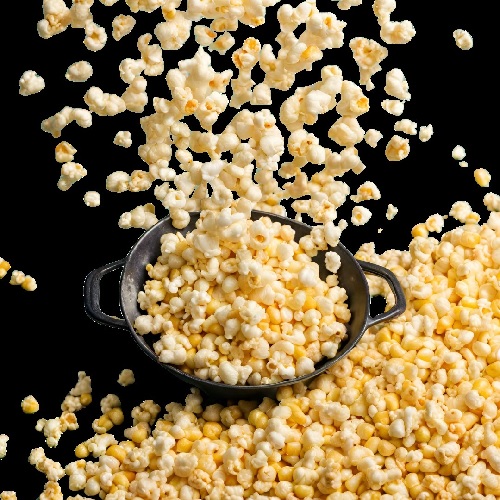
by Dr. Norazlinaliza Salim
Nanoemulsions are oil-in-water (O/W) or water-in-oil (W/O) dispersion of two immiscible liquids stabilized by a surfactant with a droplet diameter below 500 nm. Small droplet size gives them a clear or cloudy appearance which differs from the milky white color associated with coarse emulsion (whose micron-sized droplets partake in multiple light scattering). The word nanoemulsion is sometimes used interchangeably with submicron emulsion or mini emulsion; however, it should not be confused with microemulsion. Nanoemulsions despite having the same droplet size range as microemulsions, differ tremendously in structural aspects and long-term thermodynamic stability. Nanoemulsions can be rendered into several dosage forms, like liquids, creams, sprays, gels, aerosols, and foams; and can be administered by equally varying routes like topical, oral, intravenous, intranasal, pulmonary and ocular.
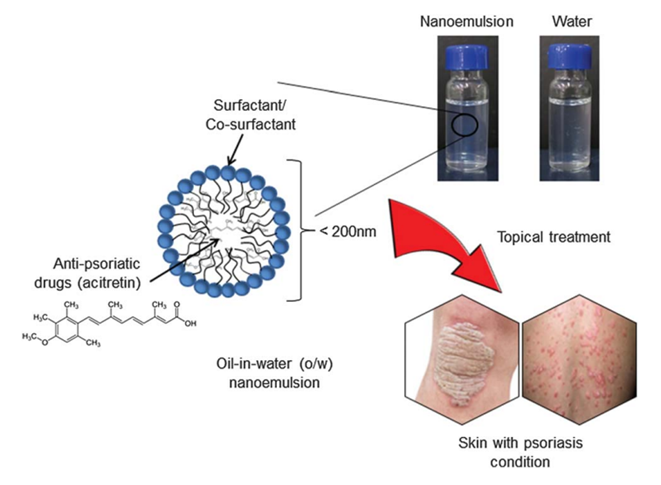
Figure 1: Example of Nanoemulsion formulation as a topical drug delivery system for psoriasis treatment

Figure 2: 2D structure of nanoemulsion system
Advantages of Nanoemulsions
Nanoemulsions with narrow size distributions, offer several advantages for topical delivery with pharmaceutical active ingredients, including controlled droplet size, the ability to efficiently dissolve lipophilic drugs, extended-release of lipophilic and hydrophilic drugs as well as can increase the hydration and viscoelasticity of the skin. Topical drug delivery also offers the advantages of patient compliance, ease of delivery, avoidance of first-pass metabolism, and avoidance of the risks and inconveniences of intravenous therapy. Because of the droplet size of nanoemulsions are very small, applying topically can enhance the drug permeation. Another advantage of topical drug delivery refers to their efficacy, in which the lower daily dose of the drug by continuous drug input avoids fluctuations in drug levels. Topical medication is an alternative to oral medication and it can be easily removed in case of poisoning. A topical medication is also suitable for self-medication, which will potentially reduce the cost of treatment.
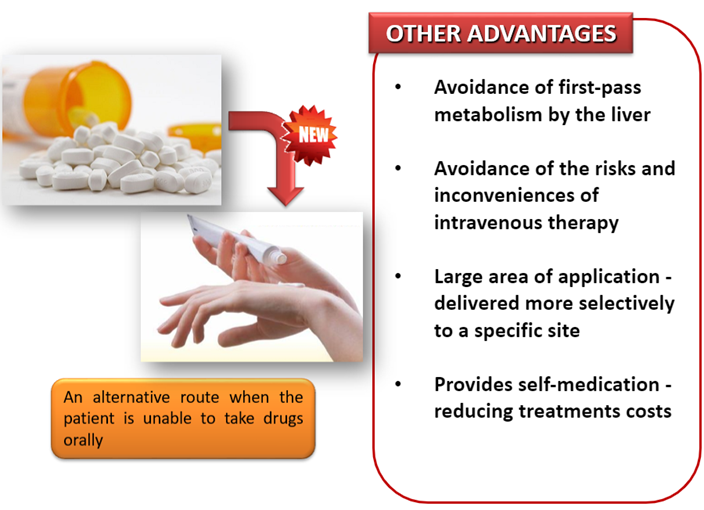
Preparation of Nanoemulsions
There are two methods that can be used for the preparation of nanoemulsions: high-energy emulsification and low-energy emulsification methods. The high-energy emulsification method uses a high-pressure homogenizer, high-shear homogenizer, microfluidization, or ultrasonication techniques. While the low-energy emulsification methods use phase inversion composition (PIC), phase inversion temperature (PIT), solvent diffusion or spontaneous emulsification (via dilution of microemulsion) techniques.
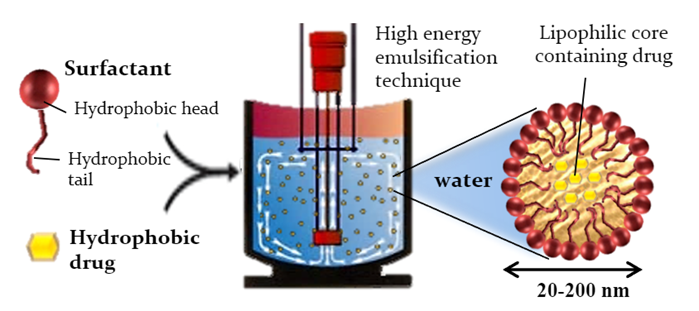
Figure 3: Example of the method used for the preparation of nanoemulsion; high-shear homogenizer
Physicochemical properties and stability study
There are several properties that distinguish nanoemulsions from the rest of emulsion systems. Nanoemulsions exhibit variations in physicochemical properties as the droplet size decreases. Drugs in nano size have a wider surface area, leading to favourable physical properties, which can be used to resolve the restriction bound by the anatomical and physiological of drug delivery in complex diseases. Two main factors in choosing nanoemulsions are their droplet size and their stability. Due to the significantly small size and low surface tension between the oil-water interfaces, the tendency of droplets to agglomerate or precipitate is almost negligible. Consequently, the rate of sedimentation or creaming is very low, which leads to a more stable nanoemulsion than other emulsion systems. Initially, it has been a challenge for most of the drug molecules to be absorbed from the GI tract or to penetrate the skin barrier. Nevertheless, nanoemulsion technology has defied the impossibility to a great extent, whereby drug molecules in a nanometer scale can cross different barriers with ease. This system can be custom-made to fit as an exclusive carrier to transport the drug to more specific and targeted areas.
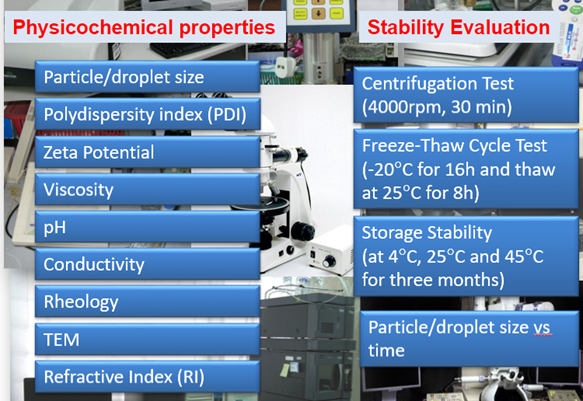
Figure 4: The list of physicochemical properties and stability study usually used to distinguish nanoemulsions
FURTHER READING
1. Rusli, I.S., Salim, N., Faujan, N.H., Kassim, N.K., Khalid, N.A.A., Rahman,M.B.A. (2021) Preparation and Evaluation of In-vitro Release and Cytotoxicity of Indigofera zollingeriana Crude Leaf Extract-loaded Nanoemulsion. Malaysian Journal of Chemistry. 23(4) 56- 65.
2. Wahgiman, N. A., Salim, N., Rahman, M. B. A., & Ashari, S. E. (2019). Optimization of nanoemulsion containing gemcitabine and evaluation of its cytotoxicity towards human fetal lung fibroblast (MRC5) and human lung carcinoma (A549) cells. International journal of nanomedicine, 14, 7323.
3. Shahidan N. S., Salim N., and Ashari S. E. (2019) Preparation and Optimization of Ibuprofen-loaded Nanoemulsion Formulation. Journal of Multidisciplinary Engineering Science and Technology (JMEST) Special Issue: Symposium on Multidisciplinary Science 2019. 6 (12). 89-96.
4. Kong, W. Y., Salim, N., Masoumi, H. R. F., Basri, M., Da Costa, S. S., & Ahmad, N. (2018). Optimization of Hydrocortisone-Loaded Nanoemulsion Formulation Using D-Optimal Mixture Design. Asian Journal of Chemistry, 30(4).5.
5. Salim, N., García-Celma, M.J., Escribano, E., Nolla, J., Llinàs, M., Basri, M., Solans, C., Esquena, J. and Tadros, T.F., 2018. Formation of Nanoemulsion Containing Ibuprofen by PIC Method for Topical Delivery. Materials Today: Proceedings, 5, pp.S172-S179.
6. Salim, N., Ahmad, N., Musa, S. H., Hashim, R., Tadros, T. F., & Basri, M. (2016). Nanoemulsion as a topical delivery system of antipsoriatic drugs. RSC Advances, 6(8), 6234-6250. (ISI, IF: 3.84, Q1).
7. Salim, N., Basri, M., Rahman, M. B., Abdullah, D. K., & Basri, H. (2012). Modification of palm kernel oil esters nanoemulsions with hydrocolloid gum for enhanced topical delivery of ibuprofen. International journal of nanomedicine, 7, 4739.8
8. Salim, N., Basri, M., Rahman, M. A., Abdullah, D. K., Basri, H., & Salleh, A. B. (2011). Phase behaviour, formation and characterization of palm-based esters nanoemulsion formulation containing ibuprofen. J Nanomedic Nanotechnol, 2(4), 1-5.
9. Rahman, M. B. A., Salim, N., Masoumi, H. R., Karjiban, R. A., Ngan, C. L., & Basri, M. (2018). Palm-based nanoemulsions for drug delivery systems. In Organic Materials as Smart Nanocarriers for Drug Delivery (pp. 209-244).
Tarikh Input: 01/11/2022 | Kemaskini: 07/11/2022 | hasniah
PERKONGSIAN MEDIA


















